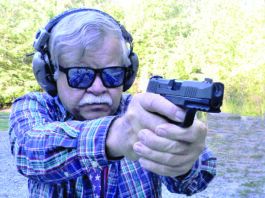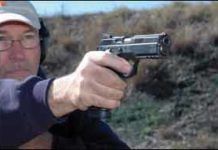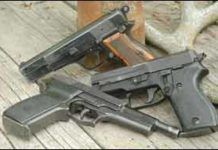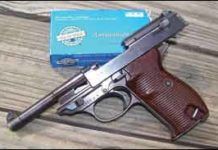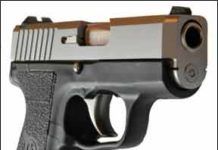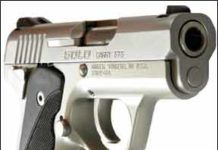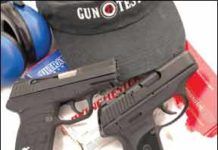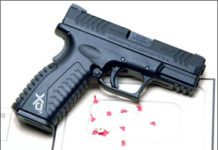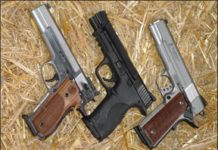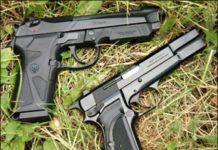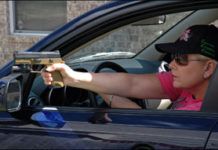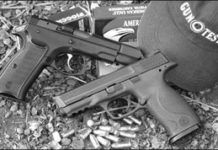9mm Practical Shooting Pistols: Glock, Springfield, and CZ USA
Three Big 9mms: SIG Sauer P6 Does It All, at a Great Price
In a happy break from our testing of tiny 9mm handguns, we took up the mantle of trying a few that border on, or maybe exceeded the envelope of, too-big nines. We acquired a trio of surplus guns from Southern Ohio Gun, fondly known as SOG, in the form of a Croatian, a Hungarian, and a German. They were all somewhat used, but not badly abused. The guns are the PHP Model MV ($200), the FEG P9M ($260), and the Sig Sauer P6 ($350). Please note that all these older test guns are not always still available by the time we get them and test them, write it all up and get our test into print. Such was the case with at least the SIG P6 of this test. We tested the three guns with Blazer 124-grain FMJ, American Eagle 115-grain FMJ, Winchester 115-grain BEB, and with Federal 124-grain Hydra-Shok. Here is what we found.
Classic Military 9mms: Luger Falls to High Power, Walther
More than 100 years ago, Georg Luger took the Borchardt pistol and redesigned it into one of the most famous military handguns of all time. While other handguns may have been better suited for warfare, none were better made of better material. Luger took the original pistol and changed the recoil spring, magazine, grip angle, barrel and even the caliber. But he kept the distinctive toggle action. The original toggle, we believe, was developed by Oliver Henry to give excellent leverage and operation in his Henry rifle, which later evolved into the Winchester '66. Maxim took the toggle action and adopted it to his first machinegun. It was only natural Borchardt and then Luger took the toggle action and adopted it to a self-loading handgun. The original Luger was chambered for the 30 Luger cartridge, just another of the many 30-caliber pistol rounds current at the turn of the previous century. But when the German Navy and later the Army demanded more smash, Luger developed the 9mm Luger cartridge. The 9mm Parabellum, aka 9mm Luger cartridge as it is variously known, was an immediate sensation.
Kahrs CM9: A Tiny Powerhouse
In recent issues we've tested a pretty good share of the increasingly popular 9mm subcompact market. So far we've looked at the Kel-Tec PF-9, Ruger's nearly identical new LC9, the Kahr CW9, and Kimber's new Solo. So far we've rated the Kel-Tec PF-9 and Kahr's CW9 as ‘A'-grade guns. The others had problems of one sort or another that kept them off the top of our list. Now we have added the brand-new Kahr CM9 ($565) to the batch and gave it to our test team to wring out. Here is what they found.
Two More Small 9mms: Solo Goes Solo Against Kahrs CW9
The trend for making smaller and smaller pistols continues, with new guns by major makers coming out every few months, it seems. We just tested the supposedly small, but actually midsize by modern standards, new Ruger LC9 against the established Kel-Tec PF-9, with the latter coming out the winner. Many 9mm handguns now come a lot smaller than that, with the Kahr PM9 and the Rohrbaugh being among the smallest. Yet the Kel-Tec PF-9 was thinner and lighter than the small Kahr, while still being large enough to grasp and shoot easily, if somewhat attention-getting on recoil.
Now Kahr has come out with a lower-priced version of the PM9 called the CM9, and we'll have one of those in hand shortly. Meantime, Kimber has announced its Solo Carry, which is in the tiny-nine world by virtue of its size. We acquired one of the Kimber Solo pistols ($747 MSRP) , and in our eagerness to test it, put it up against another nine we've never tested, Kahr's CW9 ($549 MSRP). The big question we had was, Just how small can a gun become yet still be manageable when loaded with serious ammunition? In the course of our testing another question arose, and that concerns how strong the shooter has to be to manipulate the small guns with stout-enough springs to control hot loads.
We tested them with four types of ammunition: Black Hills 147-grain FMC, Winchester 115-grain BEB, Remington 115-grain JHP, and Federal 124-grain Hydra-Shok JHP. Here is what we found.
Compact 9mms Head to Head: New Ruger LC9 Vs. Kel-Tec PF9
In our June 2008 issue we compared Ruger's then-new LCP 380 with the established Kel-Tec P-3AT, and it seemed to us that Ruger had simply cloned the little Kel-Tec. While the two guns obviously had identical designs, and some of the parts would interchange, there were some significant dimensional differences that distinguished the pair. But to us, there was no doubt Ruger had simply copied the Kel-Tec 380's design with enough changes to avoid legal problems. Now it appears Ruger has done it again, this time with its LC9 going against the Kel-Tec PF-9, both slim, single-stack, easily concealable DAO 9mm handguns. But now, instead of a $6 difference in price and not much different about the operation of the two 380s, there's a $110 extra charge for the Ruger 9mm, a third again the cost of the Kel-Tec. As we'll see, there are some notable differences.
9mm Compact Pistols: Ruger, Springfield, CZ USA, and Glock
Recently, we received a letter urging us to test more deep-concealment guns, claiming that they are the most popular gun of the day. Checking with one of the larger distributors confirmed that it is the subcompact and micro guns that are currently driving the market. In this test we're not going to evaluate pocket guns, but we are going to shoot four compact pistols that in are just one step larger than the smallest model available from each manufacturer.
The first test gun we chose was the $697 XDM 3.8 from Springfield Armory. Since the first XD pistol to hit our shores from Croatia was the Four-inch Service Model, we were tempted to refer to the XDM 3.8 as belonging to a "sub-service" category. The $525 Ruger SR9C is another new model that attempts to cross over the design of a larger pistol (the Ruger SR9) into the role of concealed carry. The $646 Glock G19 is the smaller brother of the G17, found on the hip of law enforcement worldwide. The Glock 19 gets little press, but remains popular. Another pistol that continues to perform is the CZ 75B. In this test we shoot one of its little brothers, the $651 CZ USA 75D PCR Compact.
Throughout our tests, each gun ran reliably without a single malfunction. The Glock, Ruger, and Springfield Armory pistols operated with a single continuous trigger system. The Glock 19 required a longer trigger press because movement of the trigger is what loads the spring to propel the striker, or firing pin. Release of the striker was part two of this double-action system. The XDM 3.8 utilized the trigger to release the striker after rearward movement of the slide had loaded the striker spring nearly to full strength. Pressing the trigger on the XD series pistols tops off the compression of the striker spring and releases the trigger. The Ruger SR9C works with a similar action, but the trigger applied more final compression to the striker spring than the XD/XDM. The CZ is a hammer-driven pistol with two modes of fire. Once the slide has been moved rearward, the hammer stays back [IMGCAP(2)]and trigger is used for the single action of releasing the hammer. But after using the decocker to lower the hammer to a locked position about 0.36 inches from the firing pin, pressing the trigger will perform two actions. First to move the hammer rearward, and, second, to release it toward the firing pin. To collect accuracy data, our test team fired the CZ 75D PCR Compact from the bench in single action only.
We began with three choices of test ammunition, consisting of Remington UMC 115-grain JHP rounds, Federal American Eagle 124-grain FMJ rounds and 115-grain FMJ rounds of new manufacture (red box) Black Hills ammunition. When we realized our supply of the American Eagle rounds was going to be limited, we decided to shoot our action tests with a fourth, less expensive, round. These were the Black Hills remanufactured 124-grain FMJ rounds sold in the blue boxes. Curious about the accuracy of these economical rounds, we decided to add them to our bench session. Test distance from support was 15 yards.
After accuracy data had been collected from our bench session, we set up a timed close-quarters exercise. For this test we posted a paper replica of an IPSC Metric target 7 yards downrange. The drill was to engage the target with two shots to the 5.9-by-11-inch rectangular A-zone at center mass, and then a third shot to the upper A-zone. The upper A-zone measured about 4-by-2 inches and represented the cranial pocket of this roughly humanoid silhouette. After ten runs we looked for 20 hits to the "chest" and ten to the head. Start position was holding the pistol in both hands at roughly the position one would clap their hands. We kept track of elapsed time by using a shot-activated timer and took note of our accuracy. Our operator began by dry-firing the exercise at the command of the audible start signal. Once the operator was able to completely visualize the run, at the sound of the timer the shooter was ready for live fire. But keep in mind that each gun was afforded one try and one try only at our action test. We almost broke this promise when it came time to test the CZ pistol. It was the last gun to be field tested and we suddenly realized that we had not yet fired the pistol beginning with a double-action first shot. We even went so far as to write in a warmup round on our score card. Then we decided to take the challenge and report how we shot the CZ from first-shot double action under pressure without additional practice.
Smith Lovers Quandary: Is One Of These 9mms Right for You?
In this test we have a diverse trio of pistols that offer a wide look at some of what's available in the world of Smith & Wesson's full-size 9mm handguns. We acquired a striker-fired M&P 9 Pro Series with fiber optic front sight (No. 178010, $830). Next up was a 9mm 1911-type pistol in the SW1911 Pro Series (No. 178017, $1683). Last, we assessed the Performance Center-built Model 952 (No. 170244, $2402), which is essentially a remake of the old 38-Special-only Model 52, but for 9mm ammunition.
All three of these guns felt considerably different in the hand, as though they were made on totally different planets. They were all set up to some extent for self defense. Even the 952 had a relieved magazine well for fast reloads. The M&P9 held 17+1 rounds, the SW1911 held 10+1, and the 952 held 9+1 rounds. The weights of these guns were also quite different, the heaviest being the 1911, which also had thick grip panels that we found to be a touch on the over-filling side.
We tested the trio with Fiocchi 115-grain JHP, Black Hills 147 FMJ, and with Winchester BEB 115-grain truncated-cone ammo. We evaluated the three guns for self-defensive use, and also for potential target shooting, particularly the 952. Here's what we found.
Full-Size 9mm 1911-Style Pistols: Kimber, Springfield, STI
It could be said that the Browning 1911 pistol has evolved more than any other design. The operating principal remains the same, but alternate configurations have been applied to nearly every facet of its execution. In fact, it is now commonplace to buy over the counter what not long ago would have been considered a full-blown custom pistol. We all know about beveled magazine wells, frame checkering, undercutting the trigger guard for a higher grip, high-arch memory groove grip safeties, extended magazine releases, aluminum triggers adjustable for overtravel, light rails on the dust cover, extended and/or ambidextrous safeties, checkered slide stops, skeletonized hammers, titanium firing pins, front and rear serrations on the slide, weight reducing slide cuts, lowered and flared ejection ports, full length guide rods, bull barrels, multi-spring recoil systems, external extractors, spring-loaded internal extractors, ramped barrels, adjustable sights for target, adjustable low-mount sights for carry, light-gathering-filament sights, or self-illuminating modules for front and rear sights.
In this test we will evaluate three full-size 1911-style pistols that include several of the above-mentioned features. A few years ago we would have called them factory customs, but that term is obsolete. The most distinguishing characteristic of our trio was that all were chambered for 9X19 shells, aka 9mm Parabellum or simply 9mm. They are the $1299 STI Duty One, Springfield Armory's $1277 Loaded Full Size Stainless Steel 9X19 No. PX9130LP, and the $1277 Kimber Custom Aegis II. All three guns shipped with and fed from identical 9-round MetalForm-brand single-stack magazines. Otherwise, there were significant differences between the pistols. Each gun represented a different viewpoint of what a 9mm 1911 should be. As a result, each gun had a slightly different personality, which we took into account in our grading.
The holiday season was upon us and the radio was playing old favorites like "Baby It's Cold Outside." So we accepted an offer from Houston's Top Gun Training Center to conduct our test indoors. The range was under renovation, so while the ActionTarget.com folks were working their magic on one shooting bay, we set up targets at the other end of the building. Test distance was 15 yards and Black Hills ammunition was used exclusively in our tests. For break in we opened a case of 124-grain FMJ ammunition packed in blue boxes (remanufactured). Both our 115-grain FMJ and 124-grain JHP rounds were new manufacture (packaged in red boxes). We brought in a portable shooting bench and went to work firing five-shot groups. Here is what we learned.
Two Full-Size 9mms: Browning Hi-Power Loses to Bulky 90-Two
Polymer 9mm Pistols: Green, Dark Earth, and Black Beauties
During a visit to Top Gun Range in Houston (topgunrange.com), one of our favorite retail gun shops, two colorful 9mm polymer pistols caught our eye. One was the Springfield Armory XD Service Model No. XD9201HCSP06, with an olive-drab-green frame and black slide, $543. The other pistol was the SIG Sauer P250 Compact No. 2509205, with a dark-earth-colored grip and Melonite-black slide. Both of these pistols were double-action-only, but from the operators' point of view, their unique triggers gave each gun a different personality. A comparison test was in order but we wanted to add a third pistol. That's when we found a new model from CZ USA that was also a polymer 9mm semiautomatic. The CZ USA P-07 Duty arrived as a DA/SA, traditional double-action pistol. But the P0-7 was also shipped with an optional set of ambidextrous thumb levers. When swapped out with the decocker levers, the P-07 could be fired single-action-only with a thumb-operated safety. We decided to focus our test on the single-action capability of the P-07 because it was the only mode in which operation of the trigger remained constant. This played into our desire to test three polymer nines, each with a different, but simplified, way to light the fuse.
For accuracy tests we fired from sandbag rests at targets placed a measured 15 yards downrange. We also staged a rapid-action test from a distance of 7 yards. For our 15-yard session we fired Black Hills 115-grain full-metal jacketed ammunition, (Black-Hills.com), and two choices from the catalog of Atlanta Arms and Ammo, (AtlantaArmsandAmmo.com). They were the 125-grain HAP rounds and the AAA Sub Sonic 147-grain JHP Match ammunition. For our 7-yard session we fired 124-grain FMJ rounds from Black Hills. Both the 147-grain and 124-grain rounds were sold in blue boxes, signifying that they were remanufactured ammunition. During the benchrest session, our pistols were fired utilizing a controlled press with the sights on target and the gun fully supported. Our rapid-action session was performed standing in front of a Hoffners ABC16 target, (from hoffners.com, 877-463-3637). The point of aim was the A-zone/chest area and the B-zone/head. The shooter began with the gun in both hands chest high. The muzzle was canted slightly upward so that the front sight was at the bottom of the shooter's peripheral vision. The trigger finger began resting along the frame outside the trigger guard. Upon an audible start signal from a shot-recording timer, the shooter pressed the gun toward the A-zone, fired two shots then moved the sights upward to deliver one more hit to the B-zone. We took note of shot placement and recorded the elapsed time for each of 10 recorded runs. Since we were testing at Top Gun Handgun Training Center, a public indoor range which tends to be louder than an outdoor setting, we were wearing ear plugs as well as ear muffs. Taking note of the elapsed time between the buzzer and the first shot, we kept in mind the slight delay to our hearing as well as the physical manipulation necessary to deliver a first shot. Subtracting the first shot ET from the total time told us more about recoil management, trigger control and sight alignment. Happily, none or our guns showed any hint of malfunction when firing, so we were able to concentrate on the essential operation of each weapon. Here is what we found.





























